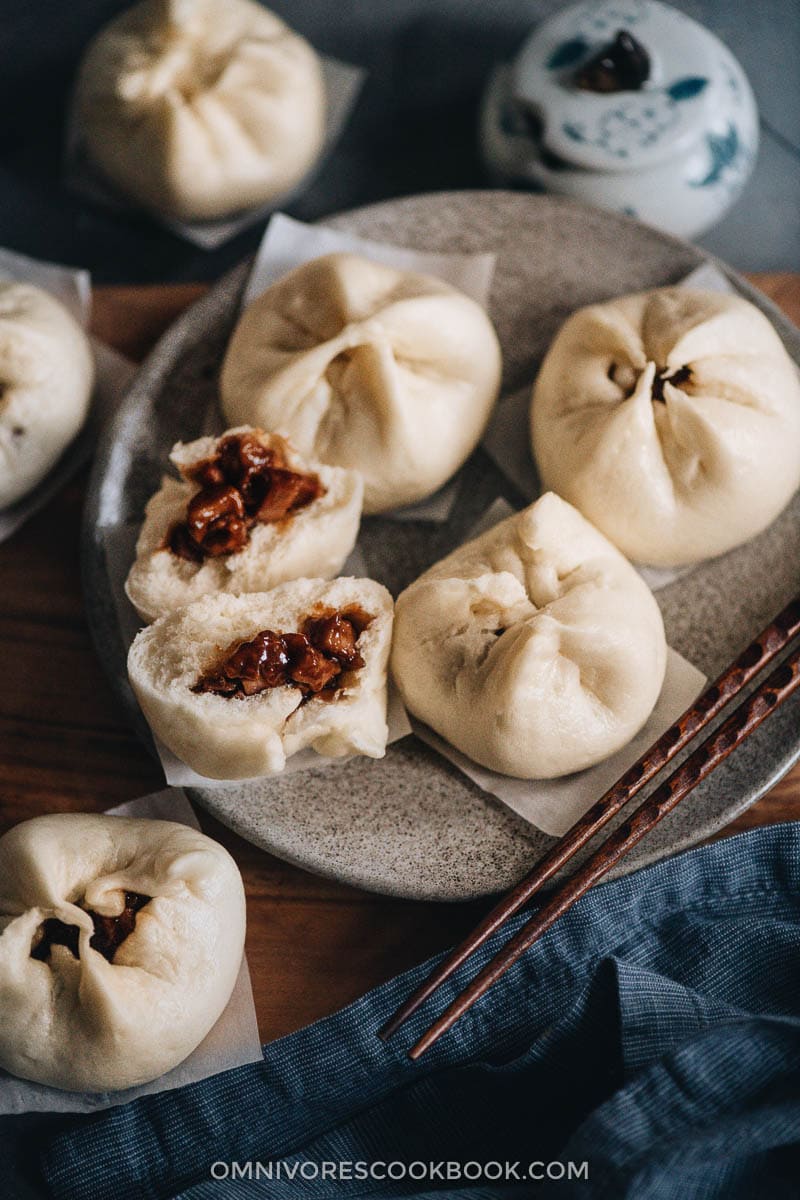
Char Siu Bao are the dim sum superstar that everybody loves. You cannot go to a dim sum restaurant and leave without having tried the super fluffy buns with chunks of BBQ pork in a bold sweet-savory sauce.
The beauty of these steamed BBQ pork buns is the soft and fluffy bread that is silky smooth on the surface. The buns crack open on the top, revealing the goodness inside and releasing its wonderful fragrance. The tender, chunky pork is coated with a sweet glaze, which pairs perfectly with the fragrant bread. It is a great way to use up leftover Char Siu (Chinese barbecue) roast pork and create something even fancier than the original dish.
Usually, something this decadent requires a lot of time and elbow grease. This recipe uses a KitchenAid stand mixer to knead the dough, so it’s quite approachable for any home cook. I also love the homemade version more than the ones from the Chinese bakery, which is often made with very fatty pork. I used lean pork to make these buns, which cuts the greasiness and still hits all the right spots.
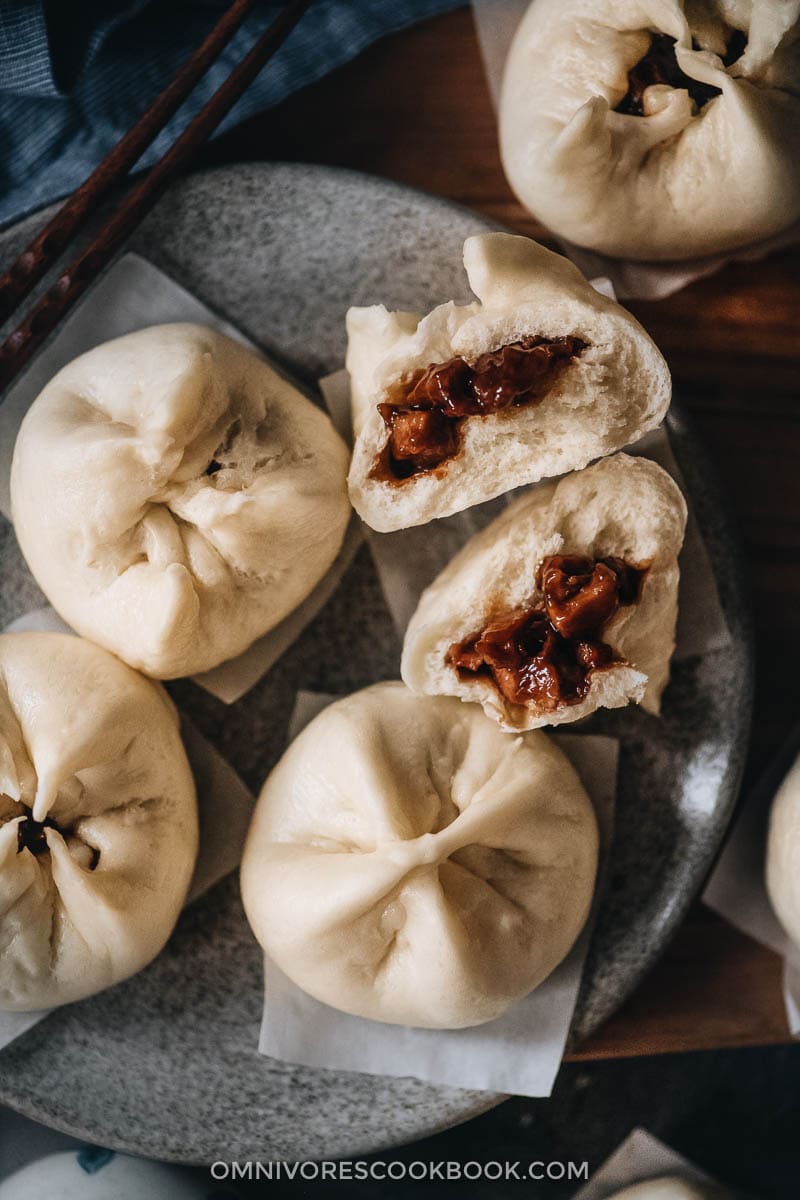
Why this recipe
- The dough is smooth on the surface, very fine in texture, and fluffy, just like the ones served at dim sum houses.
- The pork filling is super saucy, just like the authentic version.
- The recipe uses a KitchenAid stand mixer to give you maximum hands-off time. You can get these pork buns ready in under an hour once the dough is rested.
- These buns are freezer-friendly. You can make them in advance and impress guests at your dim sum party.
- I provided step-by-step pictures and a video, so you can easily follow the recipe without any prior dim sum making experience.
What flour to use
We tried both cake flour and Chinese low-gluten flour, and found that the low-gluten flour yields a marginally better result.
What is low-gluten flour
Low-gluten flour, or 低筋面粉 (Di Jin Mian Fen), is a type of flour blend that is commonly used in Asian dim sum, baked goods, and desserts. It consists of regular wheat flour with added wheat starch to create a low gluten percentage, which produces a soft-textured dough.
Note, low-gluten flour is different from cake flour, which achieves a low gluten ratio by using a different process to grind the flour.
I checked the protein content on both types of flour and found that low-gluten flour actually contains slightly more gluten content than cake flour, but still lower than all-purpose flour.
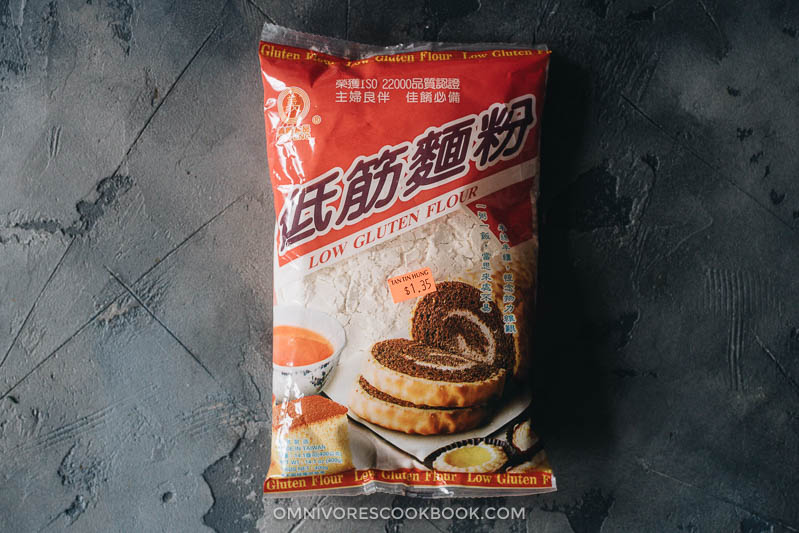
Cake flour vs. low-gluten flour
When using the low-gluten flour, the result of the buns is smoother on the surface and has that dim sum look. The texture of the dough is also a bit smoother. The cake flour yields a whiter bun (probably because the flour is bleached), but the surface is slightly uneven.
In conclusion, you should go with low-gluten flour if you’re looking for a perfect result that resembles the authentic char siu bao. If you cannot find low-gluten flour or want to skip a run to Asian grocery store, cake flour will do just fine.
Workflow
1. Prepare the dough – 1st rise
- Activate the yeast with warm water
- Mix the dry ingredients and wet ingredients in a stand mixer bowl
- Mix with a spatula a few times
- Let the mixer do the work
- The dough should be smooth once done
- Rest the dough until the size triples
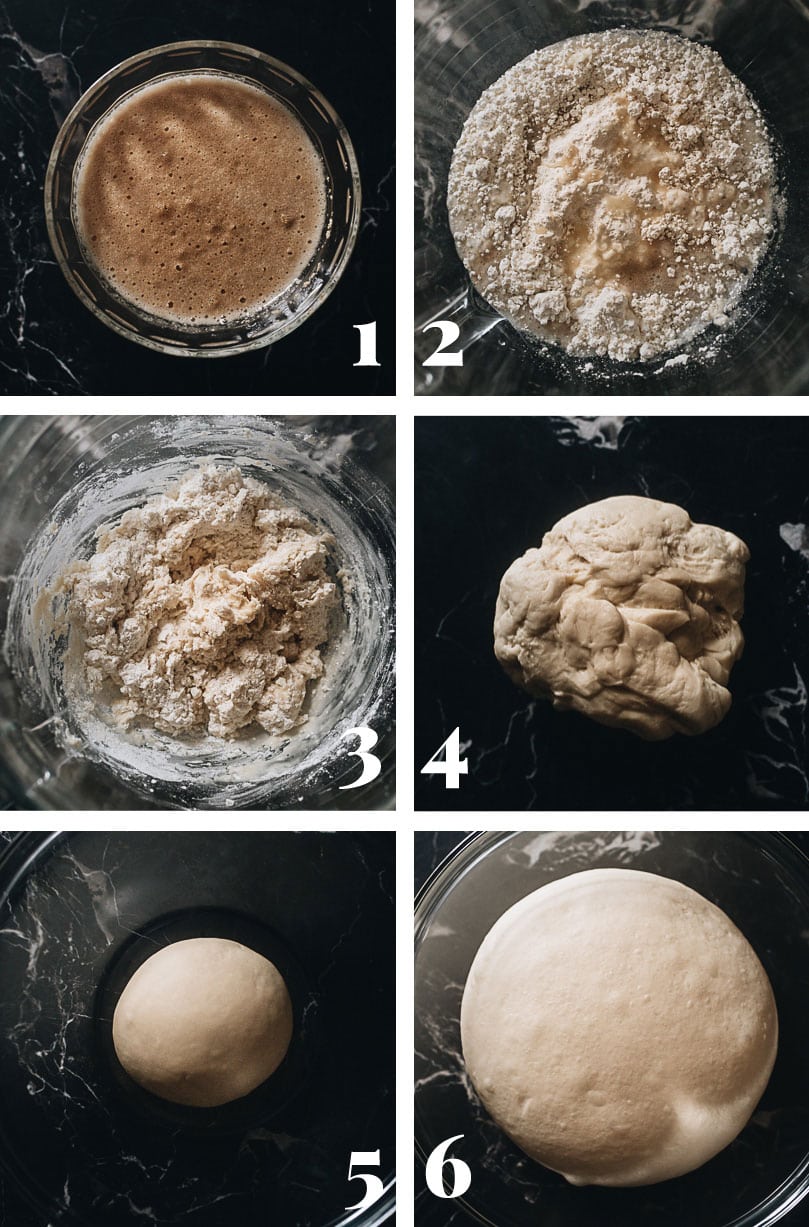
If you do not want to use a mixer, it’s possible to knead the dough with your hands, especially if you have some bread making experience. You might need to knead the dough a bit longer to achieve a good result.
2. Make the filling
- Bring the sauce mixture to a boil to melt the sugar.
- Let the sauce cool, then add the cornstarch slurry. NOTE: it’s very important to let the sauce cool down first. Otherwise, the hot sugar will cook the cornstarch and form lumps.
- Bring the sauce to a simmer once again to thicken.
- Mix the sauce with the char siu pork.
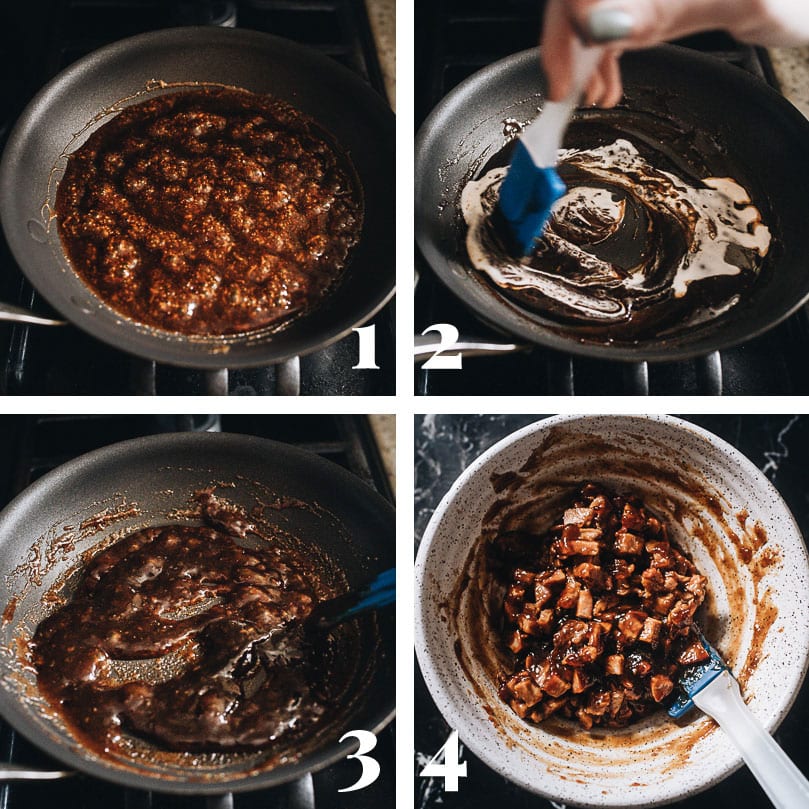
You can use the leftover pork from my Char Siu (Chinese BBQ pork) recipe, or you can purchase some char siu pork from a Cantonese restaurant. If neither works for you, try using some not-so-heavily-seasoned roasted pork from a grocery store deli. This recipe makes a very flavorful BBQ sauce so you can still get very good pork buns with regular roast pork.
3. Roll the dough
Once the dough is rested, it’s ready to use. You will need to punch the air out and divide the dough into 16 pieces.
To make the pork bun wrapper, roll the dough ball with a rolling pin to form a round disk that is thick in the center and thin on the edges. Because we will fold the buns later and that process will make top of the buns thicker. By keeping the center of the dough thicker, you will get an even thickness in the finished product.
Note: I highly recommend working on the dough in small batches. Once you divide the dough, keep the rest of the dough balls under a sheet of plastic wrap or a few layers of damp paper towels to cover the dough and prevent drying out.
Once you wrap the buns, use the same method to keep the buns from drying out while they rise the 2nd time.
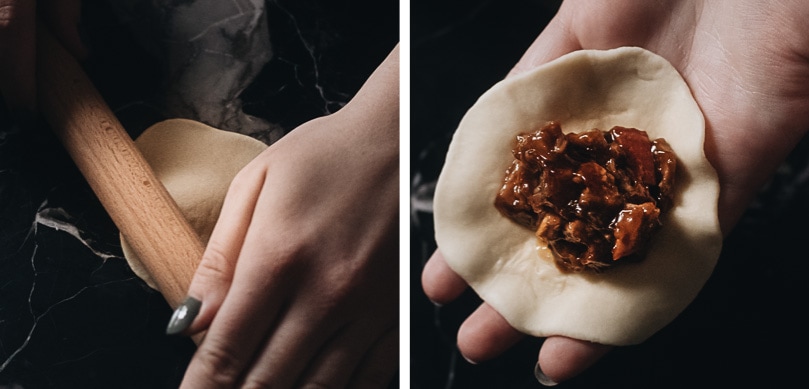
4. How to wrap char siu bao
If you’ve had char siu bao at a dim sum place, you’ll notice the buns are cracked and you can peek into them to see the juicy pork. To achieve the cracked result, you need a two-step process:
1st Fold
- Pinch together two sides of the dough
- Fold in the third side
- Press the edges together
- Fold in the fourth side
- Pinch the rest of the edges to seal the bun
- Now the bun is square and has a cross on top
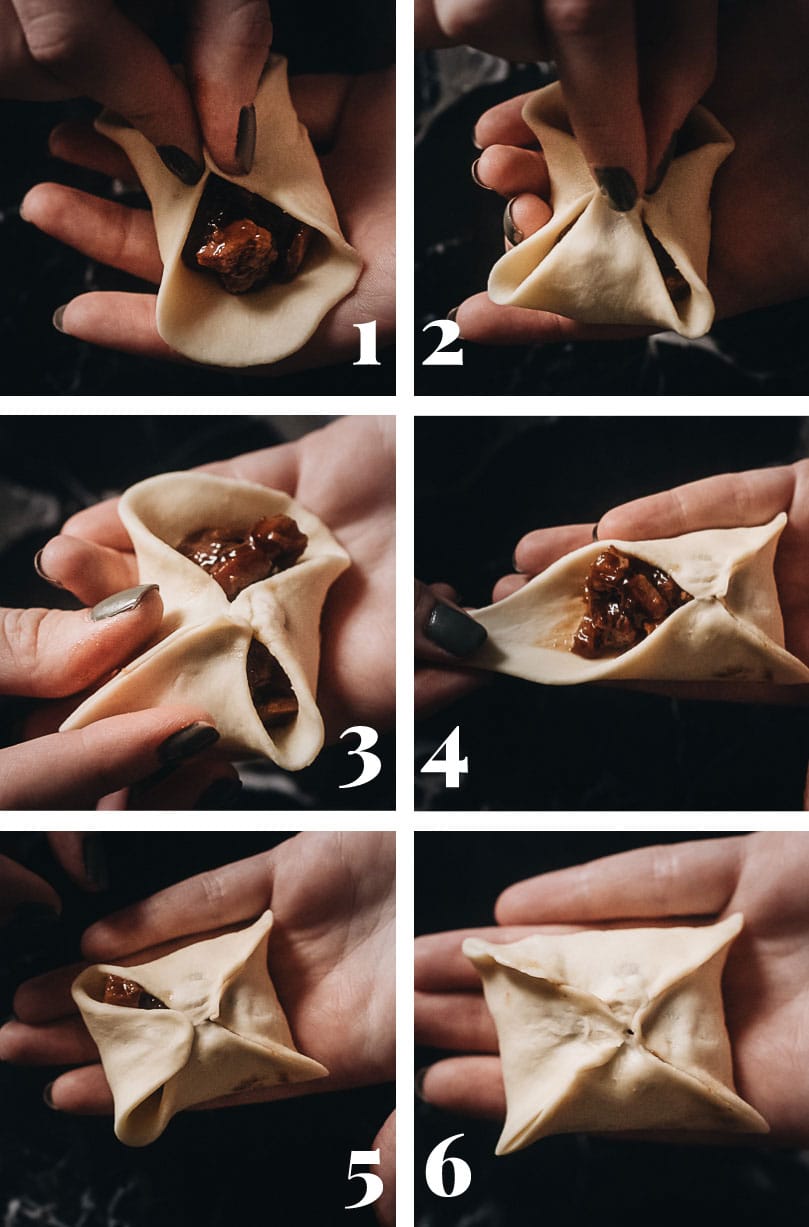
2nd Fold
- Gather the two pointed ends of the bun
- Fold and press them so the bun holds together but not super tightly (for the cracked effect)
- Work on the remaining two points in the same way
- Now it forms a round bun, which will crack open and smile at you once steamed
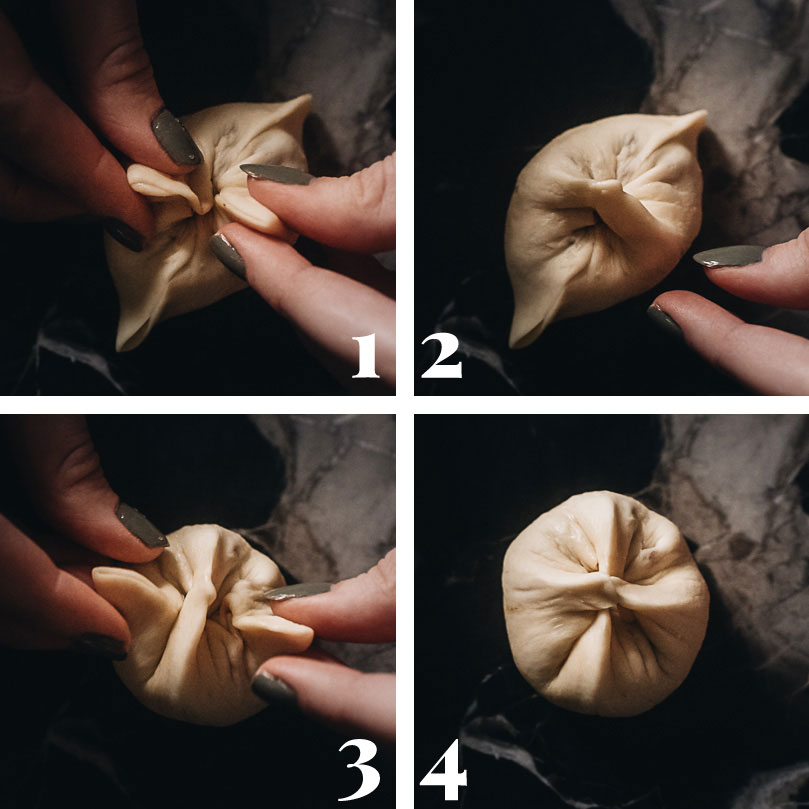
5. 2nd rise and steam
Once done wrapping, you need to allow the buns to rise for another 20 to 30 minutes before steaming.
Since it’s very hard to find a huge steamer to cook all of the buns at the same time, the best practice is to wrap and cook the buns in batches. Once you wrap 3 to 4 buns, start a stopwatch and start the steamer. The first batch of the buns is ready to cook once the stopwatch hits the 20-minute mark. Then you can work on the rest of the buns and cook them the same way.
Serve & storage
These BBQ pork buns are best when just steamed and still hot. They stay hot pretty well once cooked, in case you are preparing multiple dishes. Char siu bao are usually served as an appetizer or part of a multi-course meal. I also like to heat up leftover buns for lunch and dinner.
You can store leftover buns in the fridge for 3 days or in the freezer for a month. They hold up very well and taste great once reheated. Although I doubt you will need to store them for that long because they’ll disappear within the blink of an eye!
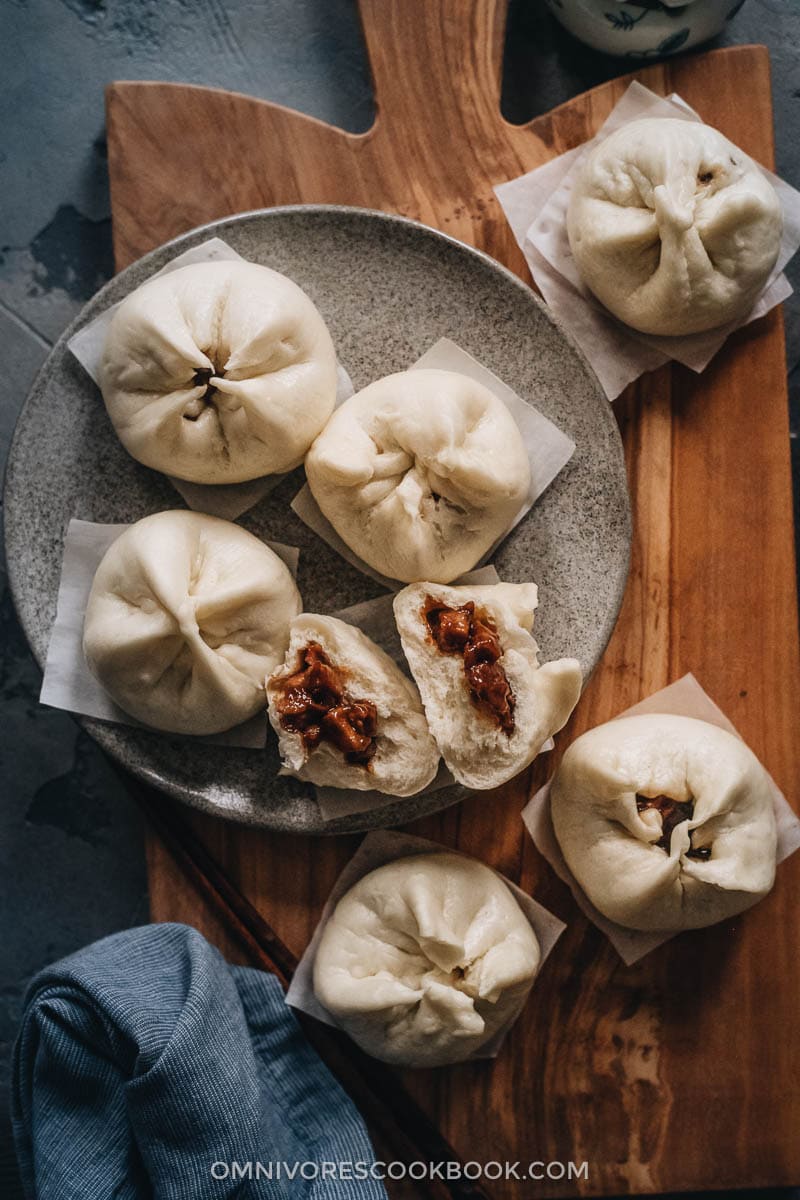
More delicious dim sum recipes
- Char Siu (Chinese BBQ Pork)
- How to Make Chinese Egg Rolls
- Wonton Soup
- Authentic Chinese Scallion Pancakes
- Steamed Ribs in Black Bean Sauce
- Chinese Steamed Custard Buns (nai wong bao)
If you give this recipe a try, let us know! Leave a comment, rate it (once you’ve tried it), and take a picture and tag it @omnivorescookbook on Instagram! I’d love to see what you come up with.
Chinese Cooking Made Easy
Are you new to this website? This free email series is a great place to start. I’ll walk you through a few of my most popular recipes and show you how and why they work. You’ll quickly start to cook better Chinese food in your own kitchen.
Watch video
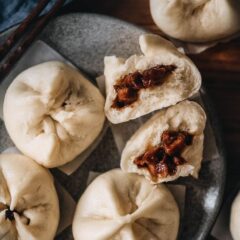
Char Siu Bao (Steamed BBQ Pork Buns)
Ingredients
Dough
- 125 g (1/2 cup) water , warm
- 7 g (1 packet / 2 teaspoons) active dry yeast
- 60 g (4 tablespoons) sugar
- 250 g (1 2/3 cup) low-gluten flour (or cake flour)
- 7 g (2 teaspoons) baking powder
- 7 g (1 1/2 teaspoons) shortening
Filling
- 1/4 cup low-sodium chicken stock
- 2 tablespoons hoisin sauce
- 2 tablespoons oyster sauce
- 2 tablespoons Shaoxing wine (or dry sherry)
- 1 tablespoon sugar
- 1 clove garlic , grated
- 1/8 teaspoon five spice powder
- 1 1/2 tablespoon cornstarch
- 1 1/2 cups Char Siu (Chinese BBQ pork) , chopped (*Footnote 1)
Instructions
Prepare the dough
- Add the water into a small bowl and warm to approximately 100-110°F (38°C), about 30 seconds in the microwave. The water should be warm, just a bit above body temperature. Add the sugar and active dry yeast, stir to mix well. Let sit for 5 minutes so the yeast will activate.
- While the yeast activates, add the cake flour and baking powder into your mixer bowl.
- Once the yeast is activated, you should see bubbles on the surface of the mixture. Pour it into the mixer bowl. Mix it with a spatula a few times, until the liquid is just absorbed by the dry ingredients.
- Install the dough hook on your mixer. Start at low speed, then gradually increase to speed setting to 6 out of 10. Knead for 10 minutes, until the dough is very smooth. Stop the mixer halfway through and scrape the dough from the sides of the bowl.
- Add the shortening. Knead on level 6 for another 5 minutes. The dough should be soft, smooth, and easily lifted from the bowl without sticking to your hands.
- Lightly grease a large bowl with butter or oil spray. Transfer the dough into the bowl. Cover the bowl with plastic wrap and let it rest in a warm part of your room, until the size triples, about 2 hours.
Prepare the char siu filling
- Combine the stock, hoisin sauce, oyster sauce, Shaoxing wine, sugar, garlic, and five spice powder in a small saucepan. Cook over medium heat until boiling. Turn to medium-low heat and let simmer for 1 minute. Stir occasionally until everything is mixed. Once done, remove the pan from the stove and let the sauce cool for 3 to 5 minutes.
- While cooling the sauce, add the cornstarch and 1 tablespoon of water into a small bowl. Stir to mix until the cornstarch is fully dissolved. Pour the cornstarch into the sauce. Stir to mix well. Turn the heat back on, to medium-low. Bring the sauce to a gentle simmer and stir constantly, until thickened. You should be able to draw lines on the bottom of the pan easily.
- Transfer the sauce into a medium-sized bowl. Add the char siu meat. Stir to mix well.
Assemble and cook
- Cut some parchment paper into 3” (7 cm) squares to hold the buns. You’ll need 16 squares.
- Punch the air out of the dough. Transfer it onto a lightly oiled working surface. Knead a few times to make the dough into a round ball. Divide the dough into 16 even pieces by cutting it into 2 even strips, then further cutting each strip into 8 small pieces. Each piece of dough should weigh 27 grams. Use your hands to roll and shape the dough pieces into dough balls.
- Wrap the buns one at a time. Flatten a dough ball using your palm. Use a rolling pin to roll the dough ball into a round disc that is thick in the middle and thin on the edges, about 2.5 to 3” (6 to 7 cm) in diameter. Carefully remove it from the surface and place it onto your palm.
- Place about a heaping tablespoon of the char siu mixture onto the center of the wrapper. Wrap the bun by pinching two ends of the dough together, then pinching the other two ends together. Press the dough edges together so it forms a square bun with a cross on top. Pinch the two opposite edges together, then repeat with the remaining two edges. Now the bun will be round. Check my blog post above to see the step-by-step wrapping pictures.
- Once done, place the char siu bun onto one of the cut parchment squares, pleated-side-down, then place it on a plate. Loosely cover it with plastic wrap to prevent drying out. Repeat the process to wrap the rest of the buns.
- Set a stopwatch (or timer) after wrapping the first bun, to keep track of the resting time. You need to rest the buns for 20 to 30 minutes before steaming them.
Steaming
- Depending on the size of your steamer, you might need to steam the buns in batches. What I usually do is prepare the steamer after wrapping half of the buns, so some of them are ready to be cooked as I work on the rest.
- To prepare the steamer, add about 3” (7 cm) of water to the pot and heat it over medium-high heat until the water starts to boil. Place the rested buns onto the steamer rack, leaving at least 2” (5 cm) between them, because the buns will expand a lot as they cook.
- Cover and steam for 10 minutes. Once done, remove the steamer rack and place it onto a trivet. Uncover the steamer rack carefully. Let the steam out and then transfer the buns onto a serving plate. Let the buns cool for 5 minutes before eating.
- Cook the rest of the buns using the same method.
Serve and store
- The char siu buns taste best when they are hot or warm. If you made them in advance, you can warm them up in the microwave or in a steamer.
- Once the buns have cooled completely, place them in a sealed container in the fridge for up to 3 days.
- You can store the cooked buns in the freezer for up to a month. To cook the frozen buns, thaw them completely in the fridge. Then heat them up in the microwave or in a steamer until heated through.
Notes
- You can use the leftover pork from my Char Siu (Chinese BBQ pork) recipe, or you can purchase char siu pork from a Cantonese restaurant. If neither works for you, try using some not-so-heavily-seasoned roasted pork from your grocery store deli. This recipe makes a very flavorful BBQ sauce so you can still make very good pork buns with regular roast pork.
Nutrition

Did you make this recipe?
I’d love to hear how it turned out for you! Please take a moment to leave a 5-star rating ⭐️ and share your thoughts in the comments further down the page. It really helps others discover the recipe too.
The recipe is updated by May 28, 2020 with a slightly adjusted filling formula. The original recipe creates extra filling you can use, and I’ve got some feedback saying the buns are too salty. We’ve retested the recipe and updated the filling with a more balanced sauce, and it will be just enough for 16 buns.
Lilja Walter is a part of the Omnivore’s Cookbook team and worked closely with Maggie to develop and test this recipe.

Dane Henas
I would like t make these but I don’t have any “shortening” (You mean like Crisco?). Can I use unsalted butter instead?
Maggie Zhu
Yes I mean Crisco in the recipe. If you don’t have it, you actually can use vegetable oil (or another neutral oil) to replace it. I think it’s better than butter because the oil doesn’t add flavor to the dough, and it contains less moisture than butter.
Jem
Delicious! My shaping needs more work but this was the perfect recipe to use up some leftover char siu I made the other night
Johnny
I don’t have a stand mixer. Could I use a food processor or muscle it out?
Maggie Zhu
You can definitely hand knead the dough. It is a very soft dough so I wouldn’t use food processor.
Roxanne
Can I also use chicken tight? I can’t eat pork.
Maggie Zhu
Yes! Chicken thigh will work great in this recipe.
Kat
I love the Char Siu pork so much, unfortunately there is never enough left overs to make these buns. These buns are a time consuming process when making the pork from scratch, but on my are they worth the effort. I have to make them as an appetizer and they don’t even make it to the table before the teens come and start grabbing them off the plate. Such a wonderful mixture of flavors and the bun has a slightly sweet flavor. This is our favorite and most requested recipe.
Lori
Love it! I don’t keep cake flour on hand so I used all purpose flour and replaced 10% of it with cornstarch (so, 225g flour and 25g cornstarch) and it turned out great. I actually made a batch of your char siu specifically for turning into these buns so it was a 2-3 day process for the whole thing and I have l no regrets
Monika Klimas
Perfection. I jave just started following your blog and it has been amazing. I wanted to add I am a professional chef and I am amazed how accurate your recipes are. The steamed buns are delicious just like from a great dim sum place. The only thing I changed was I used butter instead of shortening and it was very good.
Linda
Greetings from NSW, Australia.
These steamed pork Buns were amazing. I used your Char Siu tecipe for the pork and it was so easy. My Hubby and son are begging for more, so much so I am using this as a bribe to get things done around our home. Thank you Maggie.
Gillian
I made these for dinner tonight – the Char Siu and the Bao (both your recipes) – and wow! They tasted exactly as I’d hoped – light, fluffy dough with a sweet and fragrant pork filling. Both recipes were really easy to follow, and I loved having the vid to fall back on (eg: does my dough look right?). Thank you so much for expanding my cooking horizons with such delicious recipes.